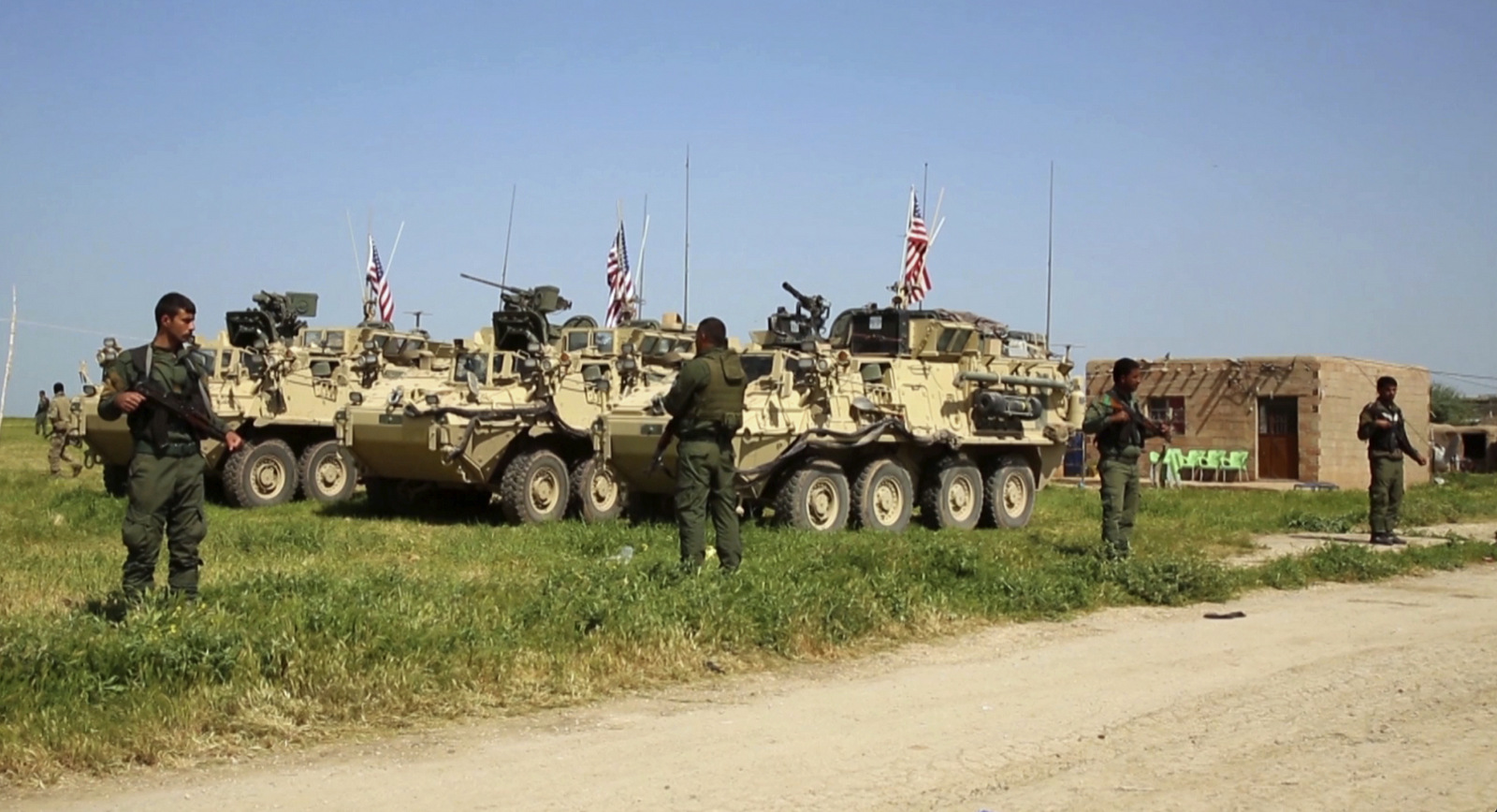
Kurdish fighters of the(YPG guard U.S. forces in the northern village of Darbasiyah, Syria, April. 29, 2017. (AP/ APTV)
WASHINGTON, D.C.– On Tuesday, President Donald Trump continued to mimic the Obama administration’s stance on Syria by approving a plan to arm the Syrian Kurdish militia known as the People’s Protection Units (YPG).
Little is known about the details of the plan, other than that it will involve the delivery of heavy weaponry to the YPG. Information on what type of weapons will be provided and how they will be delivered has not been made public. A U.S. official told NBC News that Trump’s approval would allow “the process to begin to function.”
While the U.S. has armed the Kurds with “lighter” weaponry in the past, this new move has already incensed the Turkish government, which considers the YPG to be an affiliate of the Kurdistan’s Worker Party (PKK), an organization described by both Turkey and the U.S. as a terrorist organization. Turkey repeatedly bombed the YPG in the past for this very reason.
However, for much of the length of the Syrian conflict, the U.S. has supported the YPG, one of the few non-government militias active in Syria that has been successful in fighting against Daesh (ISIS).
White House Press Secretary Spicer Confirms Plan to Send Arms to Kurds:
The latest U.S. plan to arm the YPG, though ostensibly targeting an upcoming offensive that is expected to take place in the city of Raqqa, is likely a form of retaliation against Turkey for its recent role in brokering a new de-escalation strategy in Syria with U.S. nemeses Russia and Iran.
Turkey adopted a memorandum that creates several de-escalation zones, or “safe zones,” less than a week prior to Trump’s decision to arm the Kurds with heavy weaponry. Russia announced soon after that the “safe zones” would be closed to U.S. coalition jets.
“In the de-escalation zones, aviation operations — especially by the forces of the international coalition forces — are absolutely not envisaged, with or without prior notification. This question is closed,” Russian envoy Aleksandr Lavrentyev stated on May 5. That same day, Pentagon spokesman Major Adrian J.T. Rankine-Galloway stated that “the coalition will continue to target [IS militants] wherever they operate to ensure they have no sanctuary,” even if militants are inside the safe zones.
While the U.S. has cautiously agreed to the creation of the safe zones, past ceasefires or de-escalation strategies have fallen apart due to the interference of the U.S. and its allies.
Considering the current U.S. enmity toward both Russia and Iran, it is unlikely that Turkey’s decision to broker the safe zone agreement went unnoticed by Washington. The U.S.’ decision to arm the YPG is likely a “tit for tat” move intended as an ultimatum to Turkish President Recep Tayyip Erdogan, asking him to choose between U.S. and Russian interests in the region.
Turkey’s reaction so far indicates that it is starting to make that choice, as it is now pondering the end of its “strategic partnership” with the U.S.
Nurettin Canikli, a Turkish deputy prime minister, said on Wednesday that Turkey “cannot accept the presence of terrorist organizations that would threaten the future of the Turkish state.
We hope the U.S. administration will put a stop to this wrong and turn back from it. Such a policy will not be beneficial, you can’t be in the same sack as terrorist organizations.”
Turkish Minister of Foreign Affairs Mevlut Cavusoglu echoed these sentiments, stating that “both the PKK and the YPG are terrorist organizations and they are no different, apart from their names. Every weapon seized by them is a threat to Turkey.”
Erdogan also offered his own condemnation on Wednesday, demanding that the U.S. immediately reverse its decision. His response was not altogether surprising, as he has previously registered his disapproval of the U.S.’ interactions with the YPG. In one instance, he issued an ultimatum to former President Barack Obama following a meeting between a U.S. official and YPG leadership. Erdogan demanded that Obama choose between having either Turkey or the “terrorists” as an ally.
Trump’s approval of the plan is highly likely to overshadow his first face-to-face meeting with Erdogan, which is scheduled to take place next week.
Arming the Kurds is a red line for Turkey. @akhbar https://t.co/ULPzFjj0BY
— Jenan Moussa (@jenanmoussa) May 10, 2017
The U.S. has claimed that it will risk provoking Turkey’s ire in order to ensure the victory of Kurdish forces in Raqqa – often recognized as the de facto capital of Daesh. “The (Syrian Democratic Force), partnered with enabling support from U.S. and coalition forces, are the only force on the ground that can successfully seize Raqqa in the near future,” chief Pentagon spokesperson Dana White said in a Tuesday statement.
The Syrian Democratic Force (SDF), a militia coalition in which the YPG is the dominant force, has been encircling Raqqa with the aid of U.S. support for months. The U.S. has made it clear that the SDF – and their recently created governing council – will inherit control of Raqqa following its “liberation” from Daesh with likely support from U.S. ground troops. The Raqqa initiative, while framed as a battle to liberate the city from Daesh, is much more strongly related to the U.S.’ and Israel’s long-standing plans to divide Syria.
If the U.S. continues to move forward with this strategy, Turkey will likely respond by ending its alliance with the United States as Ankara would clearly never support an autonomous region governed by Kurds near their southern border.
Source Article from http://www.mintpressnews.com/turkey-backs-russian-iranian-plan-for-syrian-safe-zones-u-s-responds-by-arming-kurds/227693/
Related posts:
Views: 0
 RSS Feed
RSS Feed















 May 11th, 2017
May 11th, 2017  Awake Goy
Awake Goy 





 Posted in
Posted in  Tags:
Tags: 
















